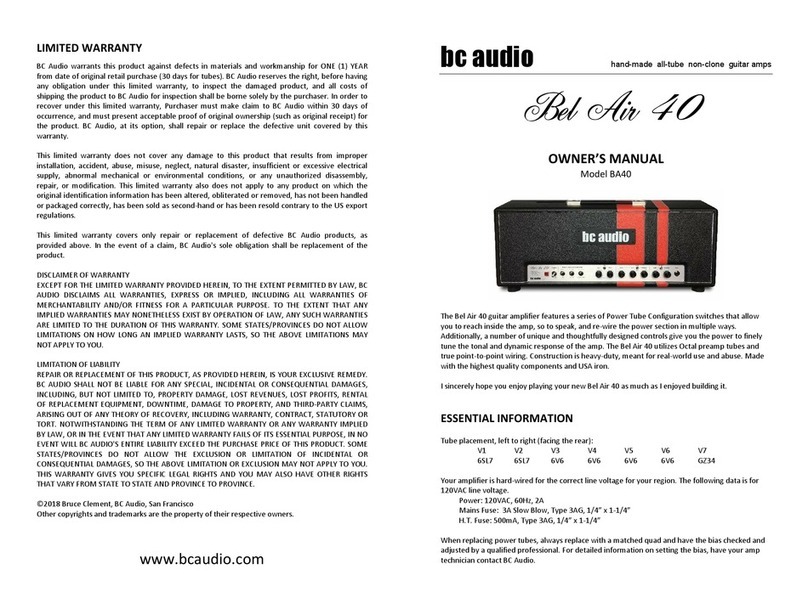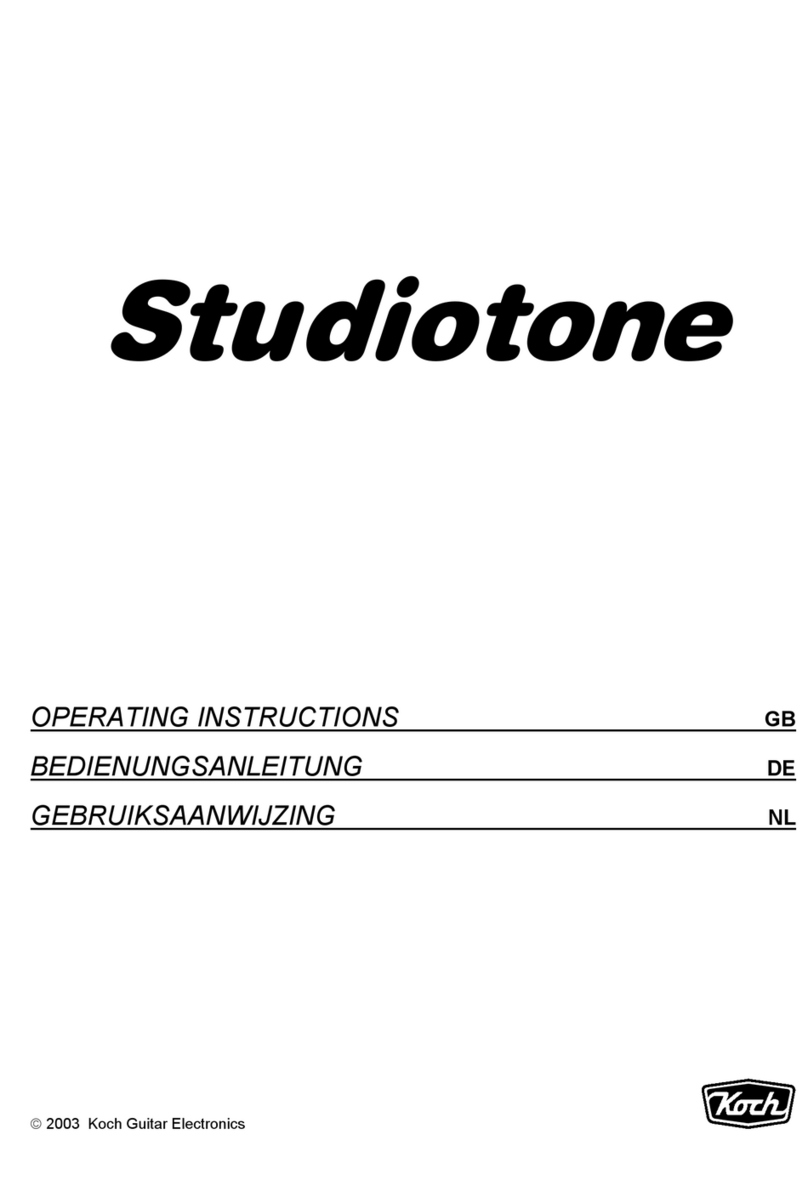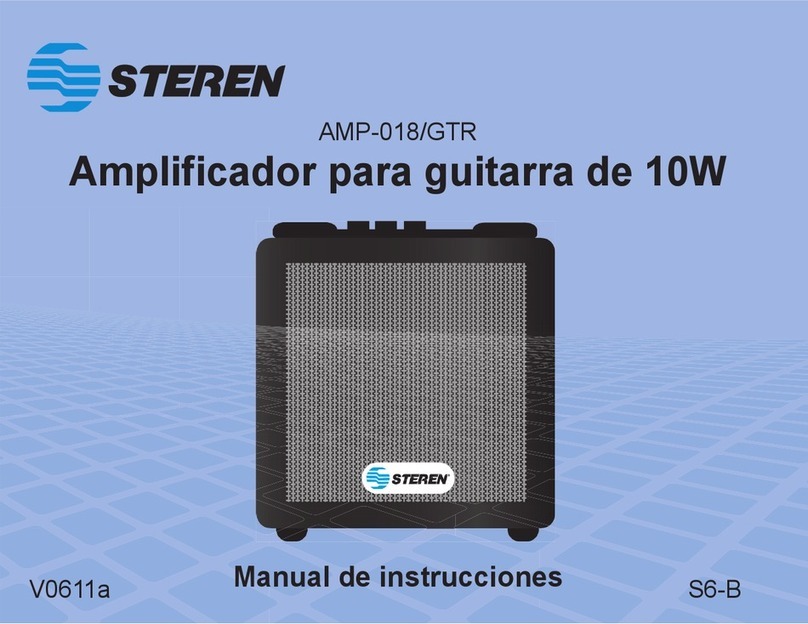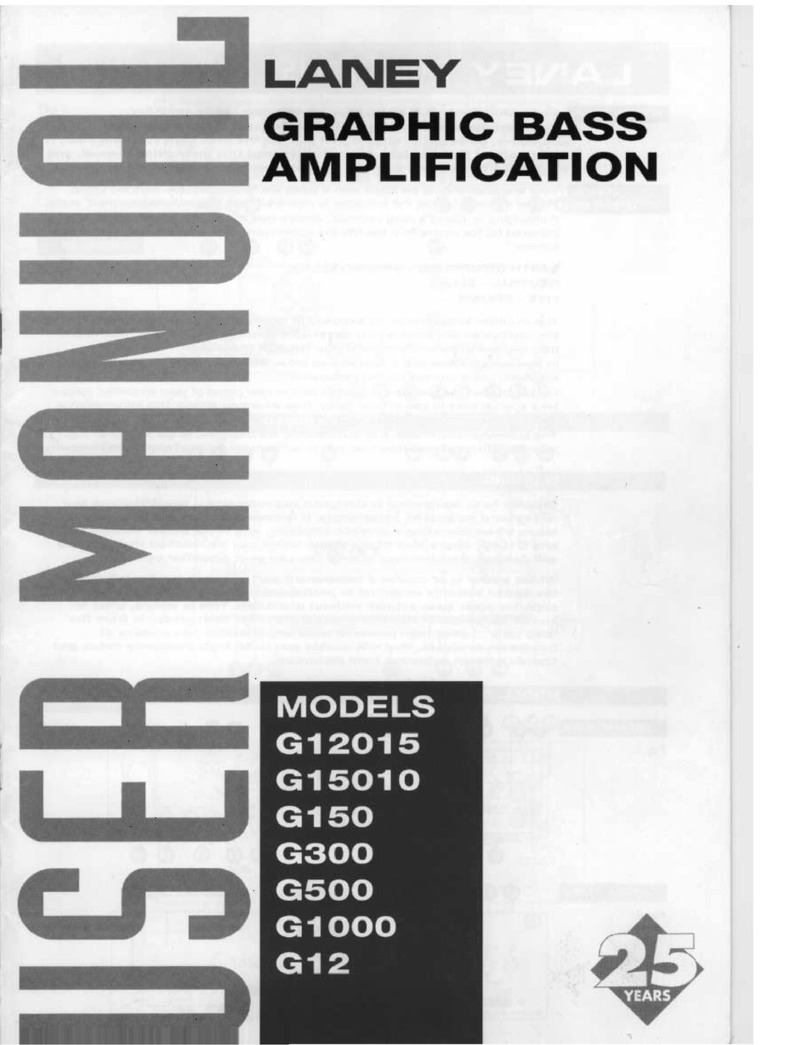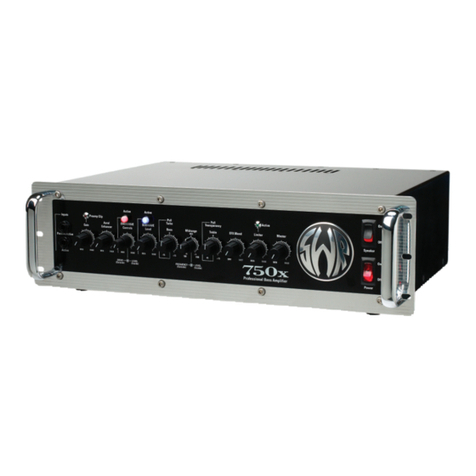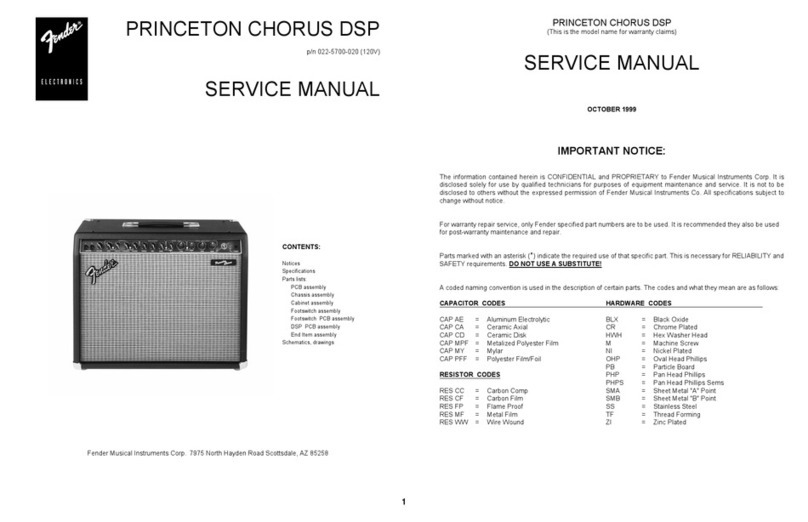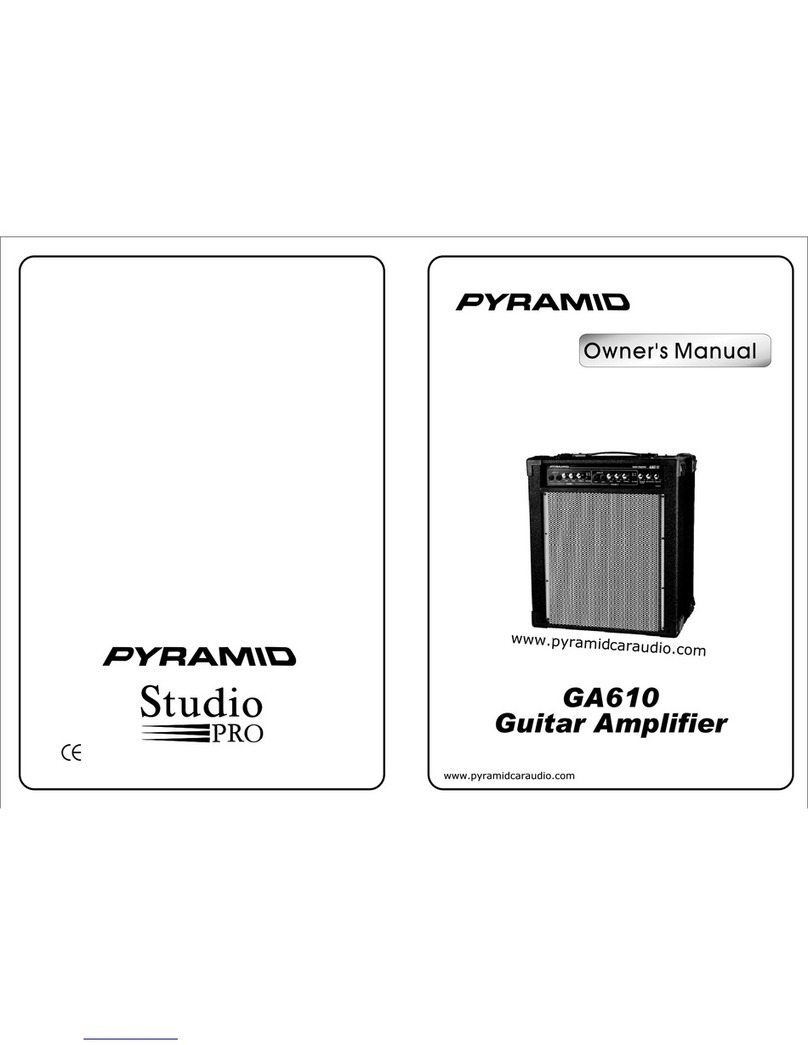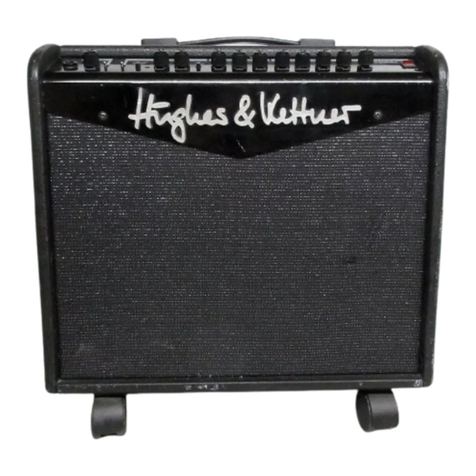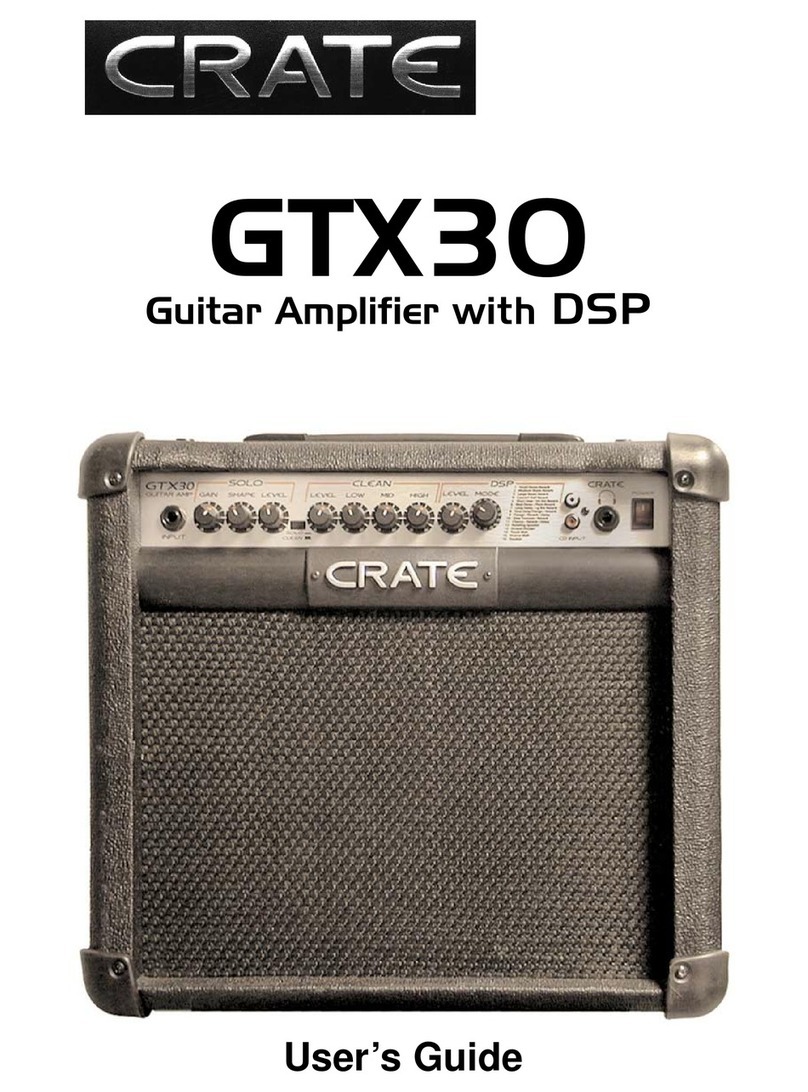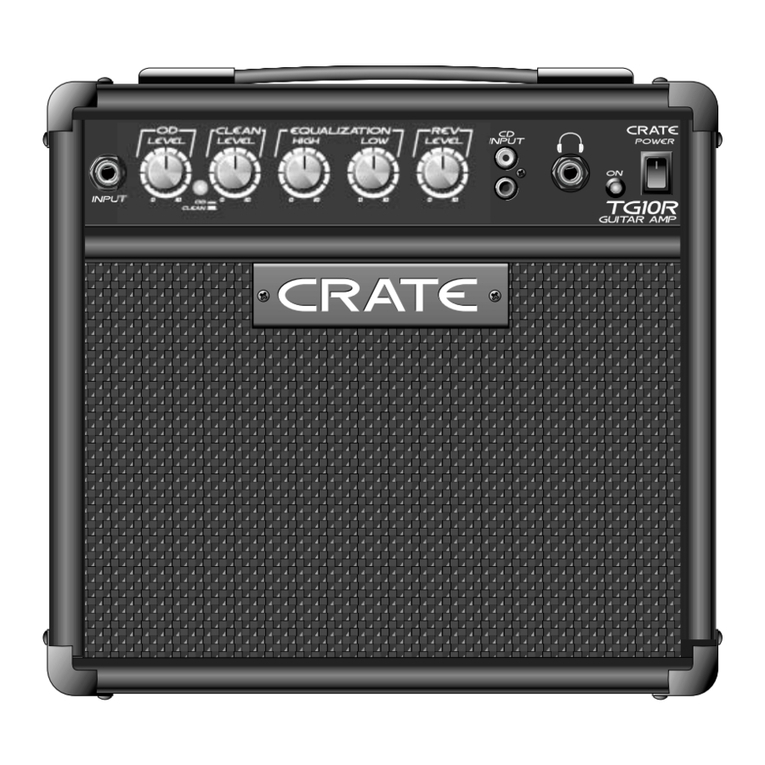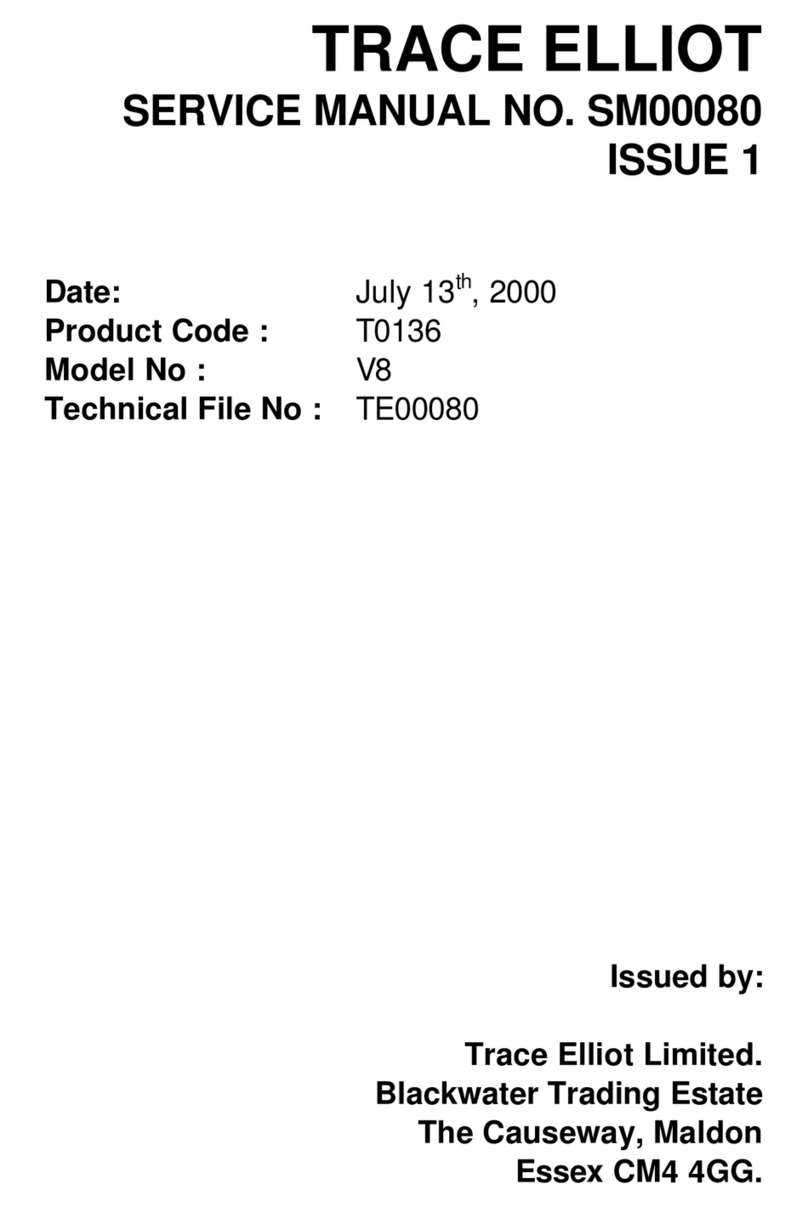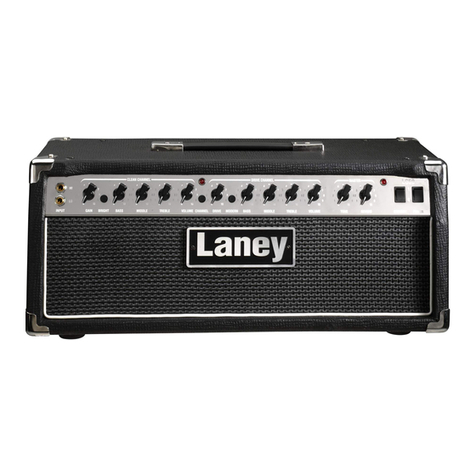BC Audio A10-Mk.II User manual

bc audio hand-made all-tube non-clone guitar amps
Amplifier No. 10
-Mk.II
OWNER’S MANUAL
Model A10-Mk.II
Congratulations on your purchase of BC Audio’s Amplifier No. 10,
developed by award winning amp builder and guitarist Bruce Clement.
That’s me.
Amplifier No. 10 is a highly flexible 50 watt Master Volume amp, meant
to be played loud and driven hard. Construction is heavy-duty, meant for
real-world use and abuse. It will drive any 4, 8 or 16 ohm cab and works
well with pedals. Amplifier No. 10 is made with the highest quality
components, USA iron, and true point-to-point wiring.
I sincerely hope you enjoy playing your new Amplifier No. 10 as much as
I enjoyed building it.

bc audio 9/2014 Amplifier No. 10 Owner’s Manual
IMPORTANT SAFETY INSTRUCTIONS
READ, FOLLOW, HEED, AND KEEP ALL INSTRUCTIONS AND WARNINGS.
• DO NOT REMOVE SCREWS ON BOTTOM. LETHAL VOLTAGES LURK INSIDE.
BOO! CONTACT THE MANUFACTURER FOR SERVICE INFORMATION. SERVICE
MUST BE PERFORMED BY QUALIFIED PERSONNEL.
• THIS AMPLIFIER IS CAPABLE OF PRODUCING HIGH SOUND PRESSURE
LEVELS. CONTINUED EXPOSURE TO HIGH SOUND PRESSURE LEVELS CAN
CAUSE PERMANENT HEARING IMPAIRMENT OR LOSS. WHAT? SPEAK UP!
USER CAUTION IS ADVISED AND EAR PROTECTION IS RECOMMENDED IF
UNIT IS OPERATED AT HIGH VOLUME. WHICH OF COURSE IT SHOULD BE.
• WHEN POWERED ON, THE TUBES MAY BECOME VERY HOT, HOT ENOUGH
TO BURN SKIN ON CONTACT. SO DON’T TOUCH ‘EM. AND KEEP OUT OF
REACH OF CHILDREN AND PETS.
• DO NOT OPERATE WITHOUT SPEAKER OR OTHER SUITABLE LOAD
CONNECTED TO THE SPEAKER JACK, AS DAMAGE MAY RESULT.
• DO NOT OPERATE NEAR ANY HEAT SOURCE.
• DO NOT OPERATE WITH VENTILATION OPENING(S) COVERED, AS THIS MAY
OVERHEAT THE AMP. DUH.
• DO NOT USE NEAR SPLASHING, FALLING, SPRAYING, OR STANDING
LIQUIDS. AND DON’T EVER LET SOME FOOL SET HIS DRINK ON YOUR RIG.
• CLEAN ONLY WITH A LINT-FREE DRY CLOTH. DO NOT USE CLEANING
AGENTS.
• CONNECT POWER CORD ONLY TO A POLARIZED, SAFETY GROUNDED
OUTLET WIRED TO CURRENT ELECTRICAL CODES AND COMPATIBLE WITH
VOLTAGE, POWER, AND FREQUENCY REQUIREMENTS STATED ON THE
APPLIANCE.
• PROTECT THE POWER CORD FROM DAMAGE DUE TO BEING WALKED ON,
PINCHED OR STRAINED.
• UNPLUG THE APPARATUS DURING LIGHTNING STORMS OR WHEN NOT IS
USE.
• REPLACE FUSE WITH CORRECT TYPE AND RATING AS INDICATED IN THIS
MANUAL AND ON THE APPLIANCE.
• ONLY USE ATTACHMENTS, ACCESSORIES, STANDS, OR BRACKETS
SPECIFIED BY THE MANUFACTURER FOR SAFE OPERATION AND TO AVOID
INJURY.
2
OVERVIEW
MAJOR FEATURES
•Built by Bruce Clement in the USA
•100% All-Tube Signal Path
•True Point-to-Point Wiring
•American-made Paper Bobbin/Paper
Layer Wound Transformers
•Custom Heavy 16ga Zinc-coated
Steel Chassis w/ Welded Corners
•Stainless Steel Hardware
•EL34 Output Section
•Octal Preamp
•Bass/Mid/Treble EQ Controls
•Master Volume Control
•Independent Gain Boost and Volume
Boost, w/ Front Panel Gain Boost
and Volume Boost Controls, Dual
Foot Switch Included
•Depth and Presence Controls
•Fully Tube-buffered Effects Loop w/
True Bypass Switch
•Individual Output Tube Bias
•Impedance Selector for 4, 8 or 16
Ohms
•120/240VAC Line Voltage Switch
TUBE COMPLEMENT
(2) EL34 Power Tubes
(4) 6SL7 Octal Preamp Tubes
SETTING BIAS
When replacing power tubes, always
replace with a matched pair and check
and adjust the bias. Amplifier No. 10 is
equipped with individual bias
adjustments for each output tube.
For detailed information on setting the
bias, have your amp technician contact
BC Audio.
ESSENTIAL INFORMATION
Tube placement, left to right (facing the rear):
V1 V2 V3 V4 V5 V6
6SL7 6SL7 6SL7 6SL7 EL34 EL34
Power (at 120VAC Input): 120VAC, 60Hz, 2A
Power (at 240VAC Input): 240VAC, 50-60Hz, 1A
Mains Fuse (at 120VAC Input): 3A Slow Blow, Type 3AG, 1/4” x 1-1/4”
Mains Fuse (at 240VAC Input): 1.5A Slow Blow, Type 3AG, 1/4” x 1-1/4”
H.T. Fuse: 500mA, Type 3AG, 1/4” x 1-1/4”
3
CONNECTIONS AND CONTROLS

bc audio 9/2014 Amplifier No. 10 Owner’s Manual
Front Panel
Rear Panel
FRONT PANEL
1. Input Jack
Plug a guitar cable into the INPUT jack, and the other end into your guitar, pedal
board or accordion.
2. Gain Control
GAIN determines the amount of gain or amplification applied to the signal, and
thus the amount of distortion. Depending on the strength of your pickups, you will
find that breakup begins when GAIN is on about 5. Increasing GAIN will bring on
more rich, thick and chocolaty distortion.
3. Gain Boost Control and Indicator
GAIN BOOST sets the amount of additional gain when engaged by the included
dual foot switch. Use Gain Boost for solos or high-gain rhythm. When engaged,
the LED indicators on the front panel and on the foot switch will light. If no foot
switch is plugged into the FOOT SWITCH jack (14), the Gain Boost is engaged.
4, 5 & 6. Bass, Mid and Treble Controls
The BASS (6), MID (5) and TREBLE (4) tone-shaping controls are located early
in the preamplifier, to shape the sound of the guitar signal coming in, before any
distortion occurs. PRESENCE (10) and DEPTH (9) (see below) are used to
shape the overall tonal response of the amplifier, including the power section.
7. Volume Control
VOLUME functions as a Master Volume control, setting the overall loudness of
the amplifier. Distortion can be obtained at any volume level by setting GAIN (2)
4
high enough to overdrive the preamp, and setting VOLUME to any desired
volume level. Setting VOLUME very high will send the power section into
overdrive, too. Yummy!
8. Volume Boost Control and Indicator
VOL BOOST sets the amount of increased volume when engaged by the
included dual foot switch. Use Volume Boost for a true increase in volume for
solos. When engaged, the LED indicators on the front panel and on the foot
switch will light. If no foot switch is plugged into the FOOT SWITCH jack (14), the
Volume Boost is engaged.
9 & 10. Presence and Depth Controls
PRESENCE (10) adjusts the amp’s overall brilliance. DEPTH (9) affects the low
frequency response. These two controls works in the amp’s power section to
change the sound and feel of the amp. Lower PRESENCE settings produce a
darker, “browner” sound (yeah, I know), while higher settings produce a brighter,
tone. Higher settings of DEPTH give the amp low-end punch and thump. You
may hear some scratchiness when rotating these controls. This is normal.
11 & 12. Power & Standby Switches
To turn on the amp, move POWER (12) to ON while leaving STANDBY (11) in
the OFF position to allow the tubes to warm up. After a half-minute or so, flip the
STANDBY switch up to the ON position. To turn the amp off, simply flip both
switches down to OFF. There’s no need to put the amp in standby mode when
shutting down.
13. Power Indicator
The Power Indicator lamp will illuminate when power is connected and the
POWER switch (12) is set to ON. If it doesn’t light, the power is not connected, or
the mains fuse (23) has blown.
REAR PANEL
14. Foot Switch Jack
Plug the included dual foot switch into the FOOT SWITCH jack. The foot switch
controls the Gain Boost (3) and Volume Boost (8) functions independently.
15-19. Effects Loop
To connect your pedals or outboard effects to the effects loop, run a standard
shielded instrument cable from the SEND jack (16) to the input of the first
outboard device. Run another instrument cable from the output of the last device
to the RETURN jack (17). Adjust SEND LEVEL (15) and RETURN LEVEL (18)
as needed. For best performance with guitar pedals, set SEND LEVEL to 5-7 and
set RETURN LEVEL to 10.
Use the FX LOOP ENGAGE/TRUE BYPASS switch (19) to engage or bypass
the loop. Signal is always present at the SEND jack, regardless of the position of
this switch.
5

bc audio 9/2014 Amplifier No. 10 Owner’s Manual
20 & 21. Speaker Output Jacks and Impedance Selector
Plug a speaker cable into either SPEAKER jack (21) and the other end into your
speaker cabinet. Be sure to use a speaker cable, not a guitar cable, or damage
to the cable, the amp and your reputation may occur. Set the IMPEDANCE
selector (20) to match the rated impedance of your speaker cabinet.
The speaker jacks are wired in parallel. If you are using two speaker cabs,
always use cabs with the same impedance. Set the IMPEDANCE selector to half
the impedance of one cab. That is, if each cab is rated at 16 ohms, two cabs will
total 8 ohms when plugged into the two SPEAKER jacks.
Do not operate the amplifier without a speaker or suitable load connected as this
can cause damage to the amplifier. It is perfectly safe to use a quality attenuator
for those quiet restaurant gigs and weddings. Say, what are you doing playing
those kinds of shows?
22 & 23. Fuses
Disconnect the power cord (24) before changing a fuse. Replace with same type
and rating only (see p. 3). The MAINS fuse (23) is on the main power input to the
amplifier. The HT or High Tension fuse (22) is on the B+ plate voltage supply.
The HT fuse may blow while the MAINS fuse is still intact. In this case, the Power
Indicator (13) will be illuminated but no sound will be produced. The HT fuse is
usually tripped by a faulty power tube.
24. IEC Power Inlet
With the POWER switch (12) in the OFF position, plug the included power cord
into the IEC power inlet, and the other end into a suitable power source. Any
medium or heavy duty cord designed to fit the standard IEC power inlet will work
fine, but Amplifier No. 10 ships with a Hospital Grade cord. Sick! Get it?
Hospital... Sick...
25. Voltage Selector (behind rear cover)
The Voltage Selector is set to your country’s voltage from the factory and does
not need to be changed unless you wish to use the amplifier in a locale with a
different voltage. The Voltage Selector is labeled 115/130. The amplifier is
designed to run on 110-120VAC or 220-240VAC. To access the Voltage
Selector, remove the rear cover.
PLAYING IT
To really hear Amplifier No. 10 and what it can do for you, I suggest you start out
by plugging your guitar directly into the amp without any pedals, rack gear or
multi-fx units. Plug in the included dual foot switch, and turn off both Boosts.
Begin with VOLUME around 2 or 3, GAIN on 5, BASS, MID and TREBLE on 5,
6
and PRESENCE and DEPTH on 0. You should be somewhere near the onset of
breakup, depending on your pickups. Adjust GAIN up and down to see how
much distortion you get at various settings.
Pre- and Post-Distortion EQ
With some moderate distortion, adjust BASS, MID and TREBLE, and note how
they affect the character of the sound. Now slowly dial in some PRESENCE and
DEPTH, and note how these two controls have a different effect on the tone than
BASS and TREBLE. If you use a lot of distortion, you’ll probably want to set
BASS on the low side. You can then increase DEPTH to bring the low end thump
back in without causing flubby distortion.
Using the Boosts
The independent Gain Boost and Volume Boost give you a great deal of flexibility
in a live performance situation, more than a typical channel-switching amp. You
can play low- or high-gain rhythm, plus have a true volume boost for solos,
whether the solo is low- or high-gain. You can play loud and clean, or not-so-loud
but fully saturated, without ever touching the amp.
Volume Boost has many useful applications beyond the obvious of being heard
over the rest of your band. Volume Boost is useful for songs with a guitar-only
intro: Start out with the Volume Boost engaged, then turn it off when the band
comes in. Or if a particular song requires a cleaner tone, engage the Volume
Boost and turn down your guitar Volume to clean up the sound.
Using Effects
Generally speaking, wah, phase and distortion pedals work best in front of the
amp – between your guitar and the Input jack – where they color the guitar signal
before the amp makes its own distortion. Chorus, delay and reverb sound best in
the loop, where they color the already distorted sound.
For best performance with guitar pedals, set SEND LEVEL to 5-7 and set
RETURN LEVEL to 10. For line level gear, raise SEND LEVEL as high as
possible without overdriving the outboard gear, and set RETURN LEVEL to
match the bypassed signal. In some cases, depending on the outboard
equipment’s ability to handle various signal levels, the perceived return level
might be lower than the bypassed signal.
The loop is fully tube-buffered and non-inverting. The loop occurs prior to the
VOLUME control and VOL BOOST circuit.
7

LIMITED WARRANTY
BC Audio warrants this product against defects in materials and workmanship for ONE (1)
YEAR from date of original retail purchase (30 days for tubes). BC Audio reserves the right,
before having any obligation under this limited warranty, to inspect the damaged product,
and all costs of shipping the product to BC Audio for inspection shall be borne solely by the
purchaser. In order to recover under this limited warranty, Purchaser must make claim to
BC Audio within 30 days of occurrence, and must present acceptable proof of original
ownership (such as original receipt) for the product. BC Audio, at its option, shall repair or
replace the defective unit covered by this warranty.
This limited warranty does not cover any damage to this product that results from improper
installation, accident, abuse, misuse, neglect, natural disaster, insufficient or excessive
electrical supply, abnormal mechanical or environmental conditions, or any unauthorized
disassembly, repair, or modification. This limited warranty also does not apply to any
product on which the original identification information has been altered, obliterated or
removed, has not been handled or packaged correctly, has been sold as second-hand or
has been resold contrary to the US export regulations.
This limited warranty covers only repair or replacement of defective BC Audio products, as
provided above. In the event of a claim, BC Audio's sole obligation shall be replacement of
the product.
DISCLAIMER OF WARRANTY
EXCEPT FOR THE LIMITED WARRANTY PROVIDED HEREIN, TO THE EXTENT
PERMITTED BY LAW, BC AUDIO DISCLAIMS ALL WARRANTIES, EXPRESS OR
IMPLIED, INCLUDING ALL WARRANTIES OF MERCHANTABILITY AND/OR FITNESS
FOR A PARTICULAR PURPOSE. TO THE EXTENT THAT ANY IMPLIED WARRANTIES
MAY NONETHELESS EXIST BY OPERATION OF LAW, ANY SUCH WARRANTIES ARE
LIMITED TO THE DURATION OF THIS WARRANTY. SOME STATES/PROVINCES DO
NOT ALLOW LIMITATIONS ON HOW LONG AN IMPLIED WARRANTY LASTS, SO THE
ABOVE LIMITATIONS MAY NOT APPLY TO YOU.
LIMITATION OF LIABILITY
REPAIR OR REPLACEMENT OF THIS PRODUCT, AS PROVIDED HEREIN, IS YOUR
EXCLUSIVE REMEDY. BC AUDIO SHALL NOT BE LIABLE FOR ANY SPECIAL,
INCIDENTAL OR CONSEQUENTIAL DAMAGES, INCLUDING, BUT NOT LIMITED TO,
PROPERTY DAMAGE, LOST REVENUES, LOST PROFITS, RENTAL OF
REPLACEMENT EQUIPMENT, DOWNTIME, DAMAGE TO PROPERTY, AND THIRD-
PARTY CLAIMS, ARISING OUT OF ANY THEORY OF RECOVERY, INCLUDING
WARRANTY, CONTRACT, STATUTORY OR TORT. NOTWITHSTANDING THE TERM
OF ANY LIMITED WARRANTY OR ANY WARRANTY IMPLIED BY LAW, OR IN THE
EVENT THAT ANY LIMITED WARRANTY FAILS OF ITS ESSENTIAL PURPOSE, IN NO
EVENT WILL BC AUDIO'S ENTIRE LIABILITY EXCEED THE PURCHASE PRICE OF
THIS PRODUCT. SOME STATES/PROVINCES DO NOT ALLOW THE EXCLUSION OR
LIMITATION OF INCIDENTAL OR CONSEQUENTIAL DAMAGES, SO THE ABOVE
LIMITATION OR EXCLUSION MAY NOT APPLY TO YOU. THIS WARRANTY GIVES
YOU SPECIFIC LEGAL RIGHTS AND YOU MAY ALSO HAVE OTHER RIGHTS THAT
VARY FROM STATE TO STATE AND PROVINCE TO PROVINCE.
©2014 Bruce Clement, BC Audio, San Francisco
Other copyrights and trademarks are the property of their respective owners.
www.bcaudio.com
Table of contents
Other BC Audio Musical Instrument Amplifier manuals


